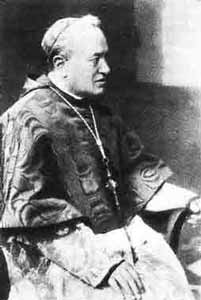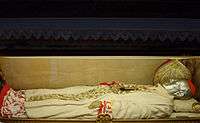Andrea Carlo Ferrari
| His Eminence Blessed Andrea Carlo Ferrari | |
|---|---|
| Archbishop of Milan | |
 | |
| Church | Roman Catholic Church |
| Archdiocese | Milan |
| See | Milan |
| Appointed | 21 May 1894 |
| Term ended | 2 February 1921 |
| Predecessor | Luigi Nazari di Calabiana |
| Successor | Achille Ratti |
| Other posts | Cardinal-Priest of Santa Anastasia (1894-1921) |
| Orders | |
| Ordination |
20 December 1873 by Domenico Maria Villa |
| Consecration |
29 June 1890 by Lucido Maria Parocchi |
| Created Cardinal |
18 May 1894 by Pope Leo XIII |
| Rank | Cardinal-Priest |
| Personal details | |
| Birth name | Andrea Ferrari |
| Born |
13 August 1850 Lalatta (Palanzano), Province of Parma, Kingdom of Italy |
| Died |
2 February 1921 (aged 70) Milan, Lombardy, Kingdom of Italy |
| Buried | Cathedral of Milan |
| Parents | Giuseppe Ferrari & Maddalena Longarini |
| Previous post |
|
| Motto | Tu fortitudo mea ("You are my strength") |
| Sainthood | |
| Feast day |
|
| Venerated in | Roman Catholic Church |
| Beatified |
10 May 1987 Saint Peter's Square, Vatican City by Pope John Paul II |
| Attributes |
|
| Patronage | |
Blessed Andrea Carlo Ferrari (13 August 1850 – 2 February 1921) was an Italian cardinal of the Roman Catholic Church who served as the Archbishop of Milan.[1]
Pope John Paul II beatified him in 1987 and his cause of canonization still continues pending a second miracle attributed to his intercession.
Life
Early life

Andrea Ferrari was born on 13 August 1850 in the village of Lalatta (Palanzano) in the Province of Parma. He was the eldest of four children to Giuseppe Ferrari and Maddalena Longarini. He received the sacrament of confirmation in 1866.
He felt called to serve as a priest and was educated at the seminary in Parma where he was to obtain a doctorate in theology in 1883. He received the subdiaconate on 21 September 1872 and the diaconate on 15 December 1872. He was ordained to the priesthood on 20 December 1873 for the Diocese of Parma where he served from 1874 until 1890.[1]
Ferrari served as the Vice-Rector of its seminary and served also as a professor of physics and mathematics in 1875. He later became its rector in 1877. He was professor of fundamental theology, ecclesiastical history and moral theology at the seminary in 1878, and published the Summula theologiae dogmaticae generalis (A Short Summary of General Dogmatic Theology) in 1885, which proved to be a respected work in the field. It was reprinted several times.[1]
Episcopate
Pope Leo XIII appointed Ferrari as the Bishop of Guastalla on 29 May 1890 and he was consecrated as a bishop on 29 June 1890 by Cardinal Lucido Parocchi who was then the Camerlengo of the Sacred College of Cardinals. He took possession of his new diocese on 3 October 1890 and was later transferred to the Diocese of Como a year later on 29 May 1891.[1]
Cardinalate
Pope Leo XIII raised Ferrari to the cardinalate and made him the Cardinal-Priest of Santa Anastasia[2] in the consistory of 18 May 1894. On 21 May 1894 he was transferred to the Archdiocese of Milan and was granted the pallium prior to his departure. Shortly after his appointment to Milan, he took Carlo as a middle name in honour of St. Charles Borromeo who was once the Cardinal Archbishop of Milan during the Counter-Reformation.
His main mission in Milan was to preserve the faith of the people through catechesis. He pushed for the publication of the Catechism of Pius X in Milan as a step towards this aim. He also visited all parishes in his archdiocese and was attentive to the social circumstances of each parish. In addition Ferrari held several episcopal conferences to discuss matters of church life.
Ferrari participated in the papal conclave of 1903 that elected Pope Pius X.
He was accused in 1907 of "Modernism" which Pius X had accepted. He was no Modernist and denounced them in a pastoral letter in 1908. Despite this the accusations put him in a negative position with Rome and he decided to keep quiet so as not to attract the ire of Pius X. The pope realized the mistake he had made in 1912. Pius X received the cardinal after this was resolved. He also partook in the conclave that elected Pope Benedict XV.[1]
Ferrari was on good terms with Angelo Roncalli - the future Pope John XXIII. The two knew the other well and Roncalli was the one who celebrated his funeral. He was also close with Achille Ratti who was his successor and future Pope Pius XI.
Death
Ferrari died on 2 February 1921 at 5:55pm after he finished the recitation of the rosary due to throat cancer and was buried in his cathedral.[1]
Beatification
Ferrari was revered by the people of Milan for the holiness of his life and his cause for canonization was officially opened by Pope John XXIII on 10 February 1963. Pope Paul VI proclaimed him to be Venerable on 1 February 1975 in recognition of his life of heroic virtue.
He was beatified by Pope John Paul II on 10 May 1987. His feast day is listed on 2 February in the Roman martyrology. In the Ambrosian Rite of Milan it is celebrated on 1 February.
In Legnano a church was constructed from 1987 to 1989 and dedicated to him. Cardinal Carlo Maria Martini consecrated the church in 1991.
References
- 1 2 3 4 5 6 "Ferrari, Andrea Carlo". Cardinals of the Holy Roman Church.
- ↑ Catholic Hierarchy
External links
| Catholic Church titles | ||
|---|---|---|
| Preceded by Prospero Curti |
Bishop of Guastalla 23 June 1890-1 June 1891 |
Succeeded by Pietro Respighi |
| Preceded by Luigi Nicora |
Bishop of Como 1 June 1891-21 May 1894 |
Succeeded by Teodoro Valfrè di Bonzo |
| Preceded by Luigi Nazari di Calabiana |
Archbishop of Milan 21 May 1894–2 February 1921 |
Succeeded by Ambrogio Damiano Achille Ratti |
| Preceded by Carlo Laurenzi |
Cardinal Priest of Sant'Anastasia 21 May 1894–2 February 1921 |
Succeeded by Michael von Faulhaber |